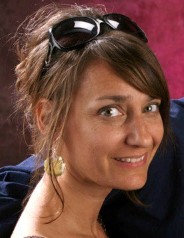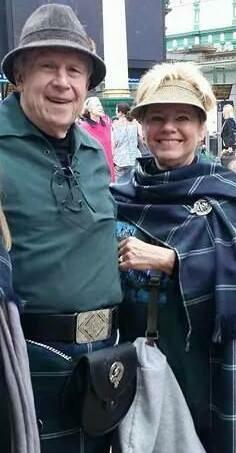Meet Our Members
Wendy Hurley - Past President
.JPG) My husband Richard and I came to Arizona about ten years ago on a vacation. During a further trip he was asked to come here to work—he tunes pipe organs. Soon we were in the throws of moving and I looked up any Scottish organizations in Phoenix. We attended a meeting in Scottsdale where we met the Ramsdells. We were invited to a Burns Night at the San Marcos Resort as their guests. Thus our connection to the Caledonian Society began. My husband Richard and I came to Arizona about ten years ago on a vacation. During a further trip he was asked to come here to work—he tunes pipe organs. Soon we were in the throws of moving and I looked up any Scottish organizations in Phoenix. We attended a meeting in Scottsdale where we met the Ramsdells. We were invited to a Burns Night at the San Marcos Resort as their guests. Thus our connection to the Caledonian Society began.
We attended meetings, offered help where required and enjoyed the time therein. I especially enjoyed helping with the planning of Burns Nights as memories of years gone by came flooding back. Being born in Scotland (Fife) and attending boarding school (Dollar Academy, Clackmannanshire) I felt very much at home. Burns Nights were the highlight of our school year.
I became President three years ago and thoroughly enjoyed the position, the planning, the meetings and all it entailed. Sadly, due to circumstances beyond my control, I had to resign after a year. Taking a step back, a deep breath and time out, I feel now ready, once again to assist where needed and look forward to many exciting evenings with fellow Scots and those of Scottish lineage and those who just love Scotland…and who wouldn't?
Jackie Carro - Long-time Member
 Jackie Carro is the owner of Marketing Ideals Company, a Tempe-based boutique agency offering marketing, public relations and video production services. Celebrating 20 years, the company serves an array of corporate clients, non-profits and also provides cultural, Valley events. Jackie Carro is the owner of Marketing Ideals Company, a Tempe-based boutique agency offering marketing, public relations and video production services. Celebrating 20 years, the company serves an array of corporate clients, non-profits and also provides cultural, Valley events.
In 1995, Jackie was presented with an opportunity to work with The Caledonian Society of Arizona and has had the distinct pleasure of playing a small role in its continued growth and success over the years. Born and raised in a New Jersey, Italian-American household, Jackie wears her honorary badge of CSA membership with great pride. When asked about one of her fondest memories or cherished moments as a Society member, Jackie replied, "There have been too numerous to count over the years, and I've enjoyed friendships with so many special people—lasting ones that I value and hold close to my heart today. I think the brightest moments I enjoy with my Scottish friends and family are the ones we share every time we get together. They are indeed a fun (and rowdy) group."
Tom and Ginni Caldwell - New Members
We live in Arizona from December to May of each year, and in Michigan from May to December…thereby living the best of both worlds! Tom is a retired school superintendent and past Director of Commerce for the State of Arizona. Ginni is a retired high school teacher.
 We joined CSA in 2011. We originally joined to become more in tune with Tom's Scottish heritage. We have not held any CSA positions. Tom is the newly elected Administrator of Clan Oliphant in all of North America. He was elected at the Clan Conference held in Scotland this month. Ginni is charged with maintaining the Clan website. We joined CSA in 2011. We originally joined to become more in tune with Tom's Scottish heritage. We have not held any CSA positions. Tom is the newly elected Administrator of Clan Oliphant in all of North America. He was elected at the Clan Conference held in Scotland this month. Ginni is charged with maintaining the Clan website.
Tom is an Oliphant. The history and Scotland properties are extensive. We just got back from a two week visit to the properties and the Clan Gathering. One notable figure in Clan Oliphant's history is Sir William Oliphant who, in 1304, held Stirling Castle with only 140 men against all of King Edward II's army of 3000+. King Robert the Bruce gave his youngest daughter, Elizabeth to Sir Walter Oliphant (Sir William's son) in gratitude for his service to himself and Scotland.
We have several favorite memories of CSA…Burns' Night, the Highland Games, helping with the Phoenix Open.
The picture of us is from the Clan March and Pipe Fest through the streets of Stirling from the Castle to the King's Knob and a photo of the plaque on the wall of Stirling Castle dedicated to Sir William Oliphant.
|